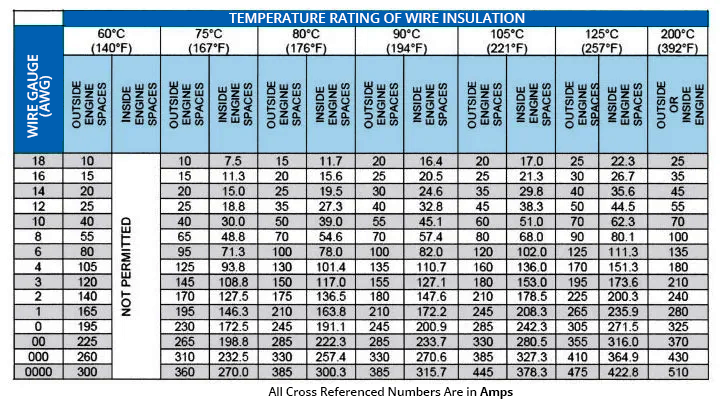Fuse Selection
Information on Fuse Selection and Location
High current in DC electrical systems comes with a risk of electrical components overheating and possibly causing a fire. A fuse is an electronic safety measure that provides overcurrent protection to an electrical circuit. It is usually a metal wire or strip that is precisely sized to melt when too much current flows through it. When sizing a fuse it is important to not undersize or oversize the fuse.
Simple Rule of Thumb Equation:
Minimum Fuse Size = Light Amp Draw at System Voltage x Number of Lights x Safety Factor of 1.4
(Round Up to Nearest Fuse Size)
For maximum fuse size refer to Amperage chart below.
When Selecting a Fuse:
- Determine the ampacity (current-carrying capacity) of the smallest wire on the circuit (you can use the table below which lists allowable amperage for conductors based on AWG size, temperature rating, and whether inside or outside of an engine space).
- Determine the maximum continuous current that will flow through the circuit. (For these calculations, it is best to assume voltage drop and battery fluctuation will cause the voltage to be below the rated system voltage, so Lumitec recommends using a voltage value of 10V for 12 volt systems and 20V for 24 volt systems).
- For safety, Lumitec recommends keeping the maximum continuous current of circuits with LED lights under 10 amps.
- Check the Ampere Interrupting Capacity (AIC) tables to find the minimum AIC acceptable for the circuit.
- Select a fuse that has an amp rating lower than the ampacity of the smallest wire, higher than the maximum continuous current, and meets the minimum AIC rating.
- If you can’t find an exact match, ABYC allows for a fuse one size higher than the ampacity of the smallest wire on non-motor loads such as LED lights, as long as the fuse rating does not exceed 150% of the ampacity.
When Choosing a Fuse Location:
- Place the fuse on the positive side of the circuit at the power source or as close to the power source as possible. (depending on the circuit layout, the power source can be the battery, the battery switch, the distribution panel, a subsidiary panel, some distribution bus bar, or other connecting point).
- If using a power source other than direct to the battery and the wire coming from the power source is sheathed or enclosed, ABYC allows for the fuse to be up to 40 inches down the wire, but no more. And if the wire is not enclosed or coming directly from the battery , the fuse should be within the first 7 inches of the wire.
What You Will Need to Know:
- System Voltage (12VDC or 24VDC).
- Current Draw at system voltage (amps) for each light on circuit (you can find this on the light product pages).
- Total Load on circuit (individual light amp draw times the number of individual lights on circuit).
- Voltage Drop (we recommend 10V for 12 volt systems and 20V for 24 volt systems).
- Safety Factor Buffer (we recommend between 1-1.4).
Useful Formulas:
- Power [watts] = Voltage [volts] * Current [amps] = (Current)^2 * Resistance [ohms]
- Total Power Draw = Power Draw from Load #1 + Power Draw from Load #2 + Power Draw from Load #3 …. + Power Draw from Load #n
- Factor of Safety = Fuse Rating / Maximum Current (to account for voltage drop and battery voltage fluctuation, Lumitec recommends a safety factor of between 1.1 and 1.4).
Definitions:
Ampacity - the maximum current, in amperes, that a conductor can carry continuously under the conditions of use without exceeding its temperature rating. Also described as current-carrying capacity.
Current – the flow of charged particles moving through an electrical conductor, measured in amperes.
Fuse - a safety device that protects electrical circuits from the effects of excessive current.
Information was referenced from: ABYC E11.10 Overcurrent Protection. More information can be found at Link Here
Allowable Amperage Chart
This chart shows the allowable amperage of single conductors when not bundled, sheathed or in a conduit.


NOTICE: Although this process uses information from ABYC E-11 to recommend wire size and circuit protection, it may not cover all the unique characteristics that may exist on a boat. If you have specitic questions about your installation please contact an ABYC certified installer.


